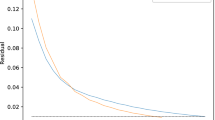Abstract
We present a novel adaptive stepping scheme for SPH fluids, in which particles have their own time steps determined from local conditions, e.g. courant condition. These individual time steps are constrained for global convergence and stability. Fluid particles are then updated asynchronously. The approach naturally allocates computing resources to visually complex regions, e.g. regions with intense collisions, thereby reducing the overall computational time. The experiments show that our approach is more efficient than the standard method and the method with globally adaptive time steps, especially in highly dynamic scenes.








Similar content being viewed by others
References
Ihmsen M, Orthmann J, Solenthaler B, Kolb A, Teschner M (2014) Sph fluids in computer graphics. In: State-of-the-art report eurographics, pp 21–42
Markus I, Nadir A, Markus B, Matthias T (2011) A parallel SPH implementation on multi-core CPUs. Comput Graph Forum 30(1):99–112
Desbrun M, Cani M-P (1999) Space-time adaptive simulation of highly deformable substances. Technical Report 3829, INRIA
Adams B, Pauly M, Keiser R, Guibas LJ (2007) Adaptively sampled particle fluids. ACM Trans Graph Proc SIGGRAPH 26(3):48
Solenthaler B, Gross M (2011) Two-scale particle simulation. ACM Trans Graph Proc SIGGRAPH 30(4):81:1–81:8
Monaghan JJ (1992) Smoothed particle hydrodynamics. Ann Rev Astron Astrophys 30:543–574
Desbrun M, Cani M-P (1996) Smoothed particles: a new paradigm for animating highly deformable bodies. In: Eurographics workshop on computer animation and simulation (EGCAS), pp 61–67. Springer, Berlin
Ihmsen M, Akinci N, Gissler M, Teschner M (2010) Boundary handling and adaptive time-stepping for PCISPH. In: Workshop on virtual reality interaction and physical simulation, pp 79–88. The Eurographics Association
Goswami P, Batty C (2014) Regional time stepping for SPH. In: Eurographics, pp 45–48. The Eurographics Association
Goswami P, Pajarola R (2011) Time adaptive approximate SPH. In: Proceedings of the 8th workshop on virtual reality interaction and physical simulation, pp 19–28. VRIPHYS
Monaghan JJ (1994) Simulating free surface flows with SPH. J Comput Phys 110(2):399–406
Becker M, Teschner M (2007) Weakly compressible SPH for free surface flows. In: ACM SIGGRAPH/Eurographics symposium on Computer animation, pp 209–217
Muller M, Charypar D, Gross M (2003) Particle-based fluid simulation for interactive applications. In: ACM SIGGRAPH/Eurographics symposium on Computer animation, pp 154–159
He X, Liu N, Li S, Wang H, Wang G (2012) Local poisson SPH for viscous incompressible fluids. Comput Graph Forum 31(6):1948–1958
Ihmsen M, Cornelis J, Solenthaler B, Horvath C, Teschner M (2014) Implicit incompressible SPH. IEEE Trans Vis Comput Graph 20(3):426–435
Akinci N, Ihmsen M, Akinci G et al (2012) Versatile rigid–fluid coupling for incompressible SPH. ACM Trans Graph TOG 31(4):62
Becker M, Tessendorf H, Teschner M (2009) Direct forcing for Lagrangian rigid–fluid coupling. IEEE Trans Vis Comput Graph 15(3):493–503
Yu J, Turk G (2013) Reconstructing surfaces of particle-based fluids using anisotropic kernels. ACM Trans Graph Proc SIGGRAPH 32(1):5:1–5:12
Bhatacharya H, Gao Y, Bargteil A (2011) A level-set method for skinning animated particle data. In: Proceedings of the 2011 ACM SIGGRAPH/Eurographics symposium on computer animation, pp 17–24. ACM
Akinci G, Ihmsen M, Akinci N, Teschner M (2012) Parallel surface reconstruction for particle-based fluids. In: Computer graphics forum, vol 31, pp 1797–1809. Wiley Online Library
Zhou ZH, Zhao JW, Cao FL (2013) Surface reconstruction based on extreme learning machine. Neural Comput Appl 23(2):283–292
Akinci N, Akinci G, Teschner M (2013) Versatile surface tension and adhesion for SPH fluids. ACM Trans Graph Proc SIGGRAPH 32(6):182
Yu J, Wojtan C, Turk G, Yap C (2012) Explicit mesh surfaces for particle based fluids. In: Computer graphics forum, vol 31, pp 815–824. Wiley Online Library
Goswami P, Schlegel P, Solenthaler B, Pajarola R (2010) Interactive sph simulation and rendering on the GPU. In: Proceedings of the 2010 ACM SIGGRAPH/Eurographics symposium on computer animation, pp 55–64. Eurographics Association
Valdez-Balderas D, Domnguez JM, Rogers BD, Crespo AJC (2013) Towards accelerating smoothed particle hydrodynamics simulations for free surface flows on multi-GPU clusters. J Parallel Distrib Comput 73(11):1483–1493
Domnguez JM, Crespo AJC, Gesteira MG (2013) Optimization strategies for CPU and GPU implementations of a smoothed particle hydrodynamics method. Comput Phys Commun 184(3):617–627
Domnguez JM, Crespo AJC, Valdez-Balderas D, Rogers BD, Gomez-Gesteira M (2013) New multi-GPU implementation for smoothed particle hydrodynamics on heterogeneous clusters. Comput Phys Commun 184(8):1848–1860
Chen JX, Fu X, Wegman J (1999) Real-time simulation of dust behavior generated by a fast traveling vehicle. ACM Trans Model Comput Simul 9(2):81–104
Chen JX, Lobo NV (1995) Toward interactive-rate simulation of fluids with moving obstacles using Navier–Stokes equations. Graph Models Image Process 57(2):107–116
Nie X, Chen L, Xiang T (2014) An efficient sleepy algorithm for particle-based fluids. Int J Comput Games Technol 2014:1–8
Keiser R (2006) Multiresolution particle-based fluids. ETH Dep Comput Sci 31(6):17971809
Horvath CJ, Solenthaler B (2013) Mass preserving multi-scale SPH. Pixar Technical Memo 13-04, Pixar Animation Studios
Orthmann J, Kolb A (2012) Temporal blending for adaptive SPH. Comput Graph Forum 31(8):2436–2449
Solenthaler B, Pajarola R (2009) Predictive–corrective incompressible SPH. ACM Trans Graph 28(3):40
Rosipal R, Girolami M, Trejo LJ et al (2001) Kernel PCA for feature extraction and de-noising in nonlinear regression. Neural Comput Appl 10(3):231–243
Acknowledgments
This work was supported by National Natural Science Foundation of China (Nos. 61272357, 61300074, 61572075) and Fundamental Research Funds for the Central Universities (FRF-BR-15-058A).
Author information
Authors and Affiliations
Corresponding author
Electronic supplementary material
Below is the link to the electronic supplementary material.
Supplementary material 1 (avi 20205 KB)
Rights and permissions
About this article
Cite this article
Ban, X., Wang, X., He, L. et al. Adaptively stepped SPH for fluid animation based on asynchronous time integration. Neural Comput & Applic 29, 33–42 (2018). https://doi.org/10.1007/s00521-016-2286-8
Received:
Accepted:
Published:
Issue Date:
DOI: https://doi.org/10.1007/s00521-016-2286-8




